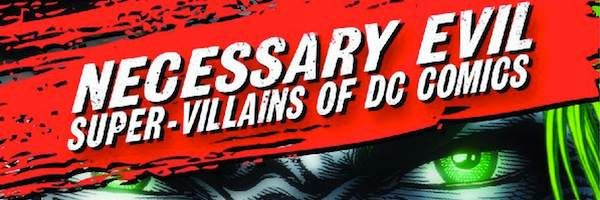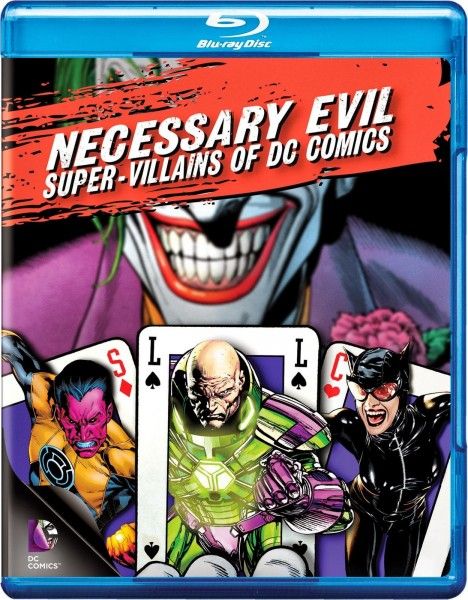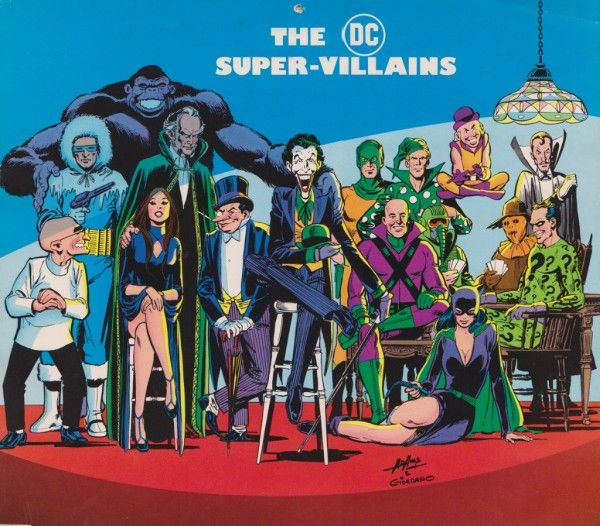The current slate of superpowered movies is all about the heroes, but what's a hero without a villain? Would Batman be as interesting if he was just taking out run-of-the-mill hoods instead of tangling with Penguin, Catwoman and The Joker? Would Superman stay in such good fighting shape if he didn't have Doomsday, Darkseid and Mongul to battle? Would Green Lantern and the Lantern Corps even be necessary if fear, anger or greed did not exist? (Will I use one declarative sentence in this intro?)
The fact remains that heroes are shaped - and sometimes created - by virtue of their villains. New to Blu-ray, Necessary Evil: Super-Villains of DC Comics explores not only the villainous characters in the DC world, but their psychoses, origin stories and contributions to their related heroes. It's a great introduction to villainy, spanning characters from the well-known to the obscure; comic nerds might find it a bit tedious as it opts to cover more villains superficially rather than focusing on fewer in depth, but it's a nice refresher nonetheless. Hit the jump for my review.
The disc opens up with the expected promos - Man of Steel, Batman: Arkham Origins, and Justice League: The Flashpoint Paradox - which are all great, but they do touch on a charitable organization, which I'd also like to bring attention to. While the focus of this Blu-ray is on evil, a promo talks up the importance of ordinary people becoming heroes with www.WeCanBeHeroes.org
Feature
“Evil isn’t just unavoidable, it’s necessary.” A pretty cool quote to start this documentary off, made all the better by the narration of consumate villain portrayer, Christopher Lee. The 99-minute picture features looks at various villains across comics, cartoons, animated movies, video games and live-action films and TV shows. They got pretty much anyone and everyone who's been part of the DC world to say a few words including interviews with Zack Snyder, Marv Wolfman, Geoff Boucher, Alan Burnett, Paul Dini, Andrea Letamendi PhD, Bobbie Chase, Geoff Johns, Ames Kirshen, Bob Harras, Scott Porter, Scott Snyder (who knows that Batman should be highlighted as the greatest detective more often), Jim Lee, Peter J. Tomasi, Dan DiDio, Dr. Travis Langley, Brian Azzarello, Marc Guggenheim, Claudia Black, Phil Morris, Andrew Kreisberg, Guillermo del Toro, Clancy Brown, Mike Carlin, Doug Mahnke, Len Wein, Andrea Romano, CM Punk, Richard Donner, Kevin Conroy, Neal Adams, James Robinson, Paul Levitz, Kevin Shinick, Glen Murakami, Tony S. Daniel, Michael E. Uslan, Alan Burnett, Brian Buccellato, Mike Carlin, and Michael Shannon, just to name a few...
Part I: Understanding Evil
Featured villains include Reverse Flash, Riddler, Larfleeze, Vandal Savage, Harley Quinn, Parallax, Darkseid, and Sinestro. Some relatively deep cuts, but more of an examination of the reasons for villains as foils for heroes, and as metaphors for our fears.
Part II: Traits of Villainy
Featuring origins and explanations of motives of such villains as Harvey Dent, Black Hand, The Anti-Monitor, Clayface #3, Mr. Freeze, Atrocitus, The Joker (lack of motive), Lex Luthor, and the Penguin. The experts point out that the reason for villainy is often more relatable and richer than a hero’s motive.
Part III: Evil in Perspective
An examination of nature vs nurture in villainy, a look at the story from the point of the villain, and morality/code of ethics for villains, including Man-Bat, General Zod, Scarecrow, Lobo, Deadshot, Deathstroke, Amanda Waller, Ra’s Al Ghul, The Rogues, and more.
Part IV: Evil on the Attack
The villain as he or she relates to their hero; the best villains bear similarities or are mirror images of their hero, or are the result of a divergence from the hero. An exploration of villain’s powers and a look at the instances when the hero falls. Villains include Ocean Master, Reverse Flash, Captain Cold, Catwoman, Riddler, Penguin, Joker, Black Adam, Crime Syndicate of America, Talia Al Ghul, Star Sapphire, Mongul, Darkseid, Ra’s Al Ghul, Black Manta, Bane, and Doomsday.
Part V: Villains Classified
Villains grouped into certain themes:
- Monsters: Solomon Grundy, Bizarro
- Mad Scientist: Doctor Sivana, Ultra-Humanite,
- Dictators/Overlords: General Zod, Starro the Conqueror,
- Mafia Crimeboss: The Penguin
- Femme Fatale: Catwoman, Poison Ivy, Harley Quinn, Cheetah,
- Rogues Galleries: Batman (Joker, Penguin, Ivy, etc), Superman (Braniac, The Parasite, Metallo), Wonder Woman (The First Born)
Part VI Villains United:
A look at the various team-ups of villains, including The Crime Syndicate, The Secret Society, The Rogues, The Legion of Doom. Also an exploration of the pros and cons of supervillain team-ups featuring The Rogues – Mirror Master, Heat Wave, Captain Cold, who all go up against Flash; Suicide Squad – villains forced to be heroes by a government organization, and the rare occurrences when a team of villains cooperates with a team of heroes to take on a foe that's greater than either group alone.
Part VII Final Redemption:
An interesting look at when a hero becomes a villain – or a villain finds salvation. Highlights include the Injustice storyline - death of Lois and Superman’s unborn child; and Hal Jordan – the death of Guardians at his hands, he goes mad with power, and becomes Parallax. An exploration of concepts of second chances and redemption, with Cry for Justice – Prometheus takes over one of the heroes and figures out a way to destroy Star City, leads to redemption for Green Arrow. Other redemptive villain arcs include: Black Adam – corrupted over time, found redemption through family and love, and loss; The Dark Knight Returns – Joker and Dr. Wolper.
Part VIII “The New 52” and Beyond:
A retrospective look at the company-wide relaunch two years later, which resulted in a darker and scarier universe where the attacks on heroes and civilians come without warning and are more personal. The new state of comics is less about good and evil, and more about order and chaos. They explore the Court of Owls storyline, the Guardians of the Universe – the first lantern (metaphor for buried emotions), freed and returns the emotions to the Guardians, just before Sinestro kills them; Aquaman – new kingdom of sea creatures he must battle as he tries to find his footing on land. There's also a look at DC branching from the comics to other media, the “Forever Evil” comic celebration of villains (Justice League is dead and villains inherit the Earth)
At the end of the day, Necessary Evil: Super-Villains of DC Comics is a great introduction for those looking to become more informed on the world of villains and a nice refresher for long-time comic fans. It's not an in-depth discussion on any one topic or character, but rather a broad exploration of the recurring themes and psychoses that occur across DC's properties. As a final note, the only thing more perfect than Lee’s narration is ending the documentary with the Joker’s laugh.



